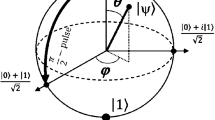Abstract
Entanglement is perhaps the most important new feature of the quantum world. It is expressed in quantum theory by the joint measurement formula. We prove the formula for projection valued observables from a plausible assumption, which for spacelike separated measurements is a consequence of causality. State reduction is simply a way to express the joint measurement formula after one measurement has been made, and its result known.
Similar content being viewed by others
References
Busch, P., Lahti, P., and Mittelstaedt, P. (1991). The Quantum Theory of Measurement, Springer, Berlin.
Cohen-Tannodji, C., Diu, B., and Laloë, F. (1977). Quantum Mechanics, Herman/Wiley, Paris.
Davies, E. B. (1976). Quantum Theory of Open Systems, Academic Press, London.
Jordan, T. (1983). Quantum correlations do not transmit signals. Physics Letters A 94, 264.
Kraus, K. (1983). States, Effects, and Operations, Springer, Berlin.
Leggett, A. J. (1992). On the nature of research in condensed-state physics. Foundation of Physics 22, 221.
Macdonald, A. (2002). Quantum theory without measurement or state reduction problems. Available: http://faculty.luther.edu/∼macdonal
Mermin, D. (1981). Bringing home the atomic world. American Journal of Physics 49, 940.
Mermin, D. (1985). Is the moon there when nobody looks? Physics Today 38(4), 38.
Ozawa, M. (1997a). Quantum state reduction and the quantum bayes principle. In Quantum Communication, Computing and Measurement, O. Hirota et al., eds., Plenum, New York. Also quant-ph/9705030.
Ozawa, M. (1997a). An operational approach to quantum state reduction. Annals of Physics 259, 121. Also quant-ph/9706027.
Ozawa, M. (1998a). Quantum state reduction: An operational approach. Fortschritte der Physics 46, 615. Also quant-ph/9711006.
Ozawa, M. (1998b). On the concept of quantum state reduction: Inconsistency of the orthodox view, quant-ph/9802022.
Ozawa, M. (2000a). Operational characterization of simultaneous measurements in quantum mechanics. Physics Letters A 275, 5. This is a letter version of Ozawa, 2000c. A similar paper is available as quant-ph/9802039.
Ozawa, M. (2000b). Measurements of nondegenerate discrete observables. Physical Review A 62, 062101. Also quant-ph/0003033.
Ozawa, M. (2000c). Operations, disturbance, and simultaneous measurability, quant-ph/0005054.
Svetlichny, G. (2002). Causality implies formal state collapse, quant-ph/0207180.
Zanchini, E. and Barletta, A. (1991). Absence of instantaneous transmission of signals in quantum theory of measurement. Nuovo Cimento B 106, 419.
Zurek, W. (1991). Decoherence and the transition from quantum to classical. Physics Today 44(10), 36.
Author information
Authors and Affiliations
Rights and permissions
About this article
Cite this article
Macdonald, A. Entanglement, Joint Measurement, and State Reduction. International Journal of Theoretical Physics 42, 943–953 (2003). https://doi.org/10.1023/A:1025414305027
Issue Date:
DOI: https://doi.org/10.1023/A:1025414305027



